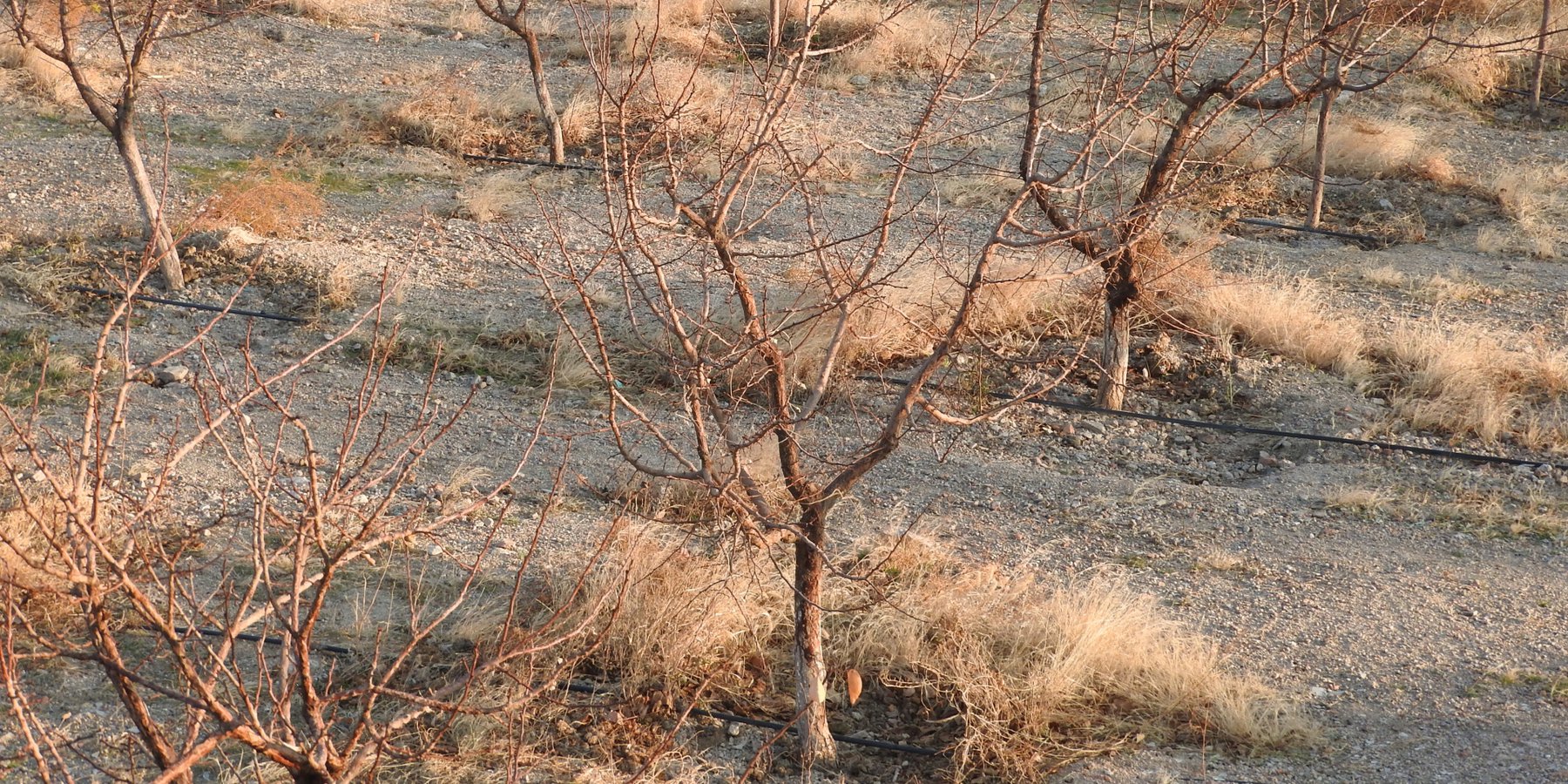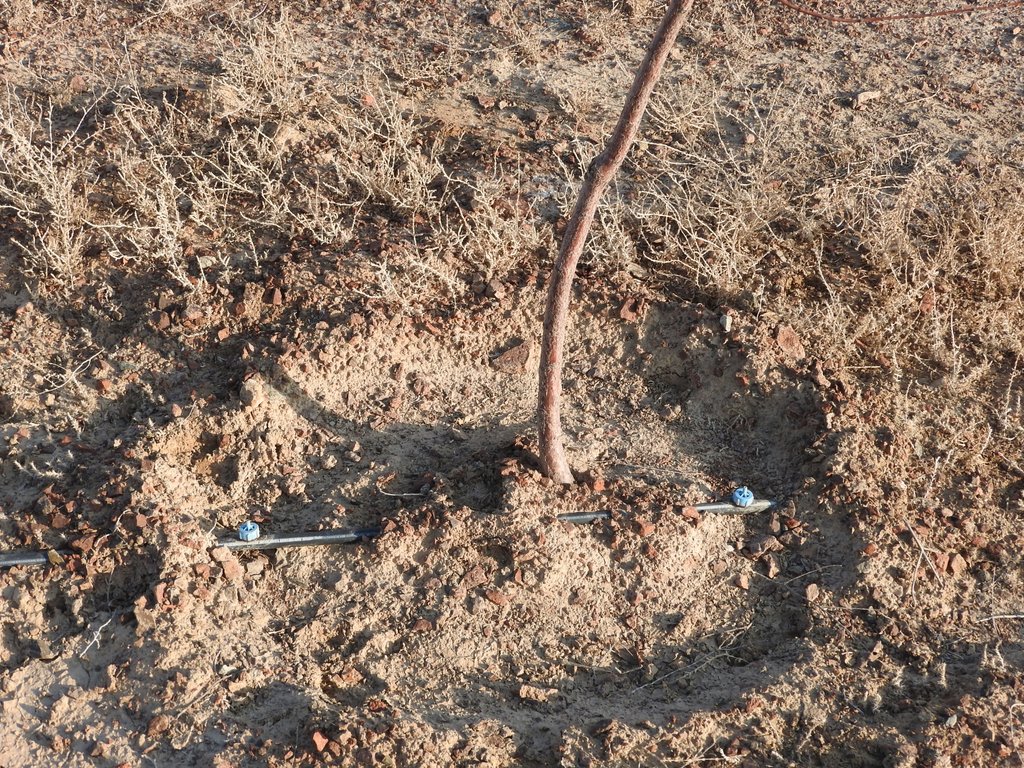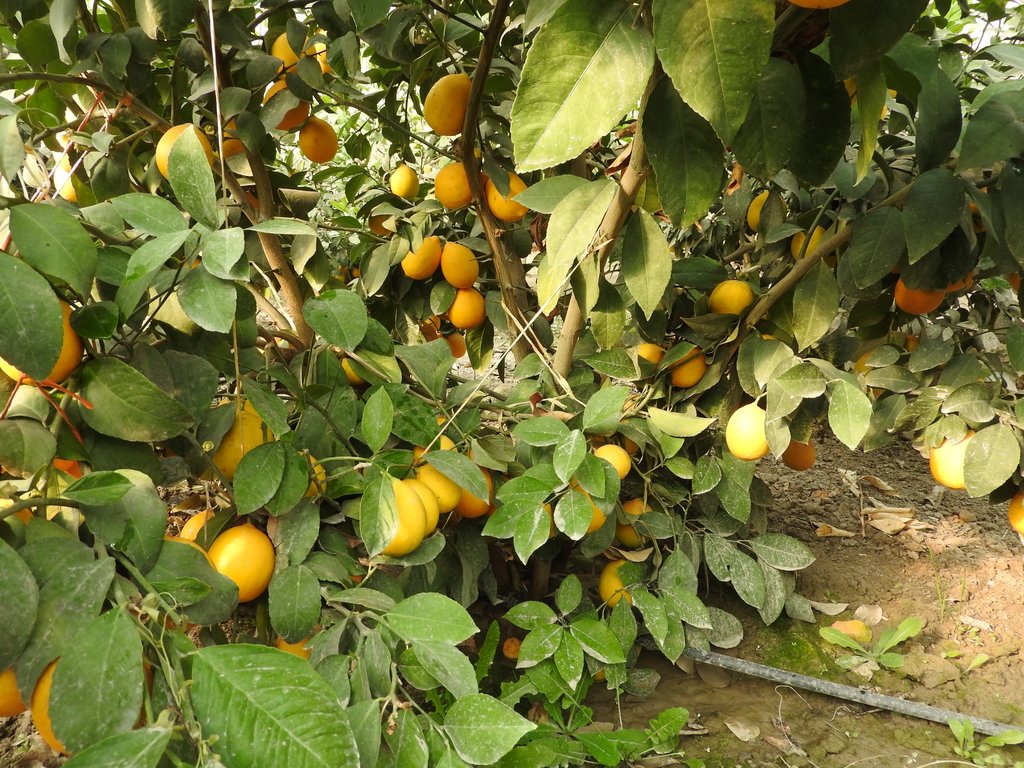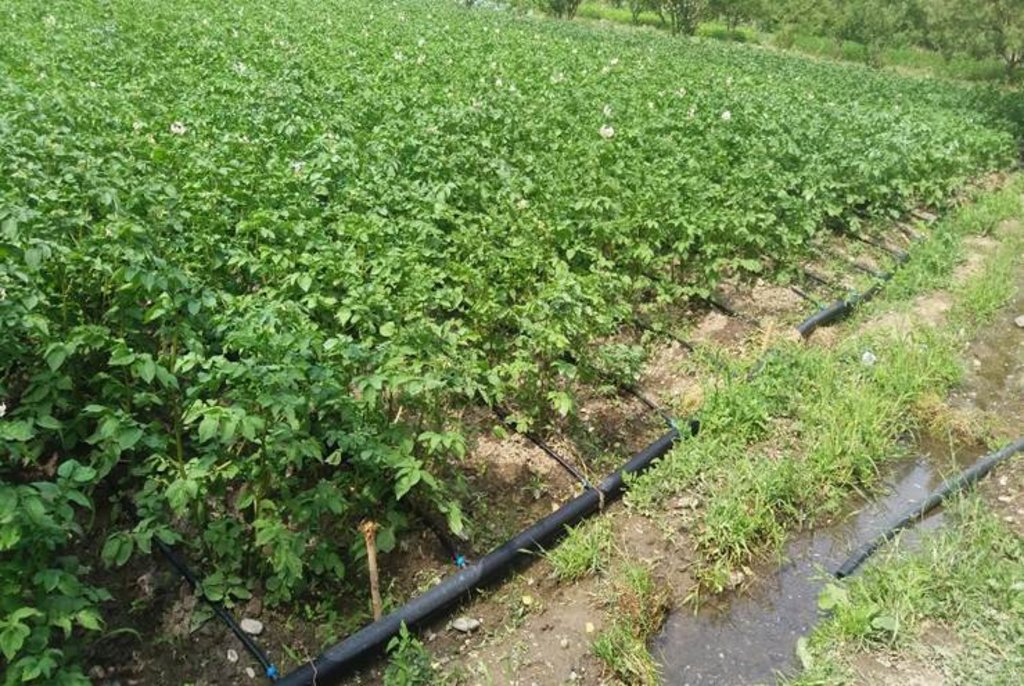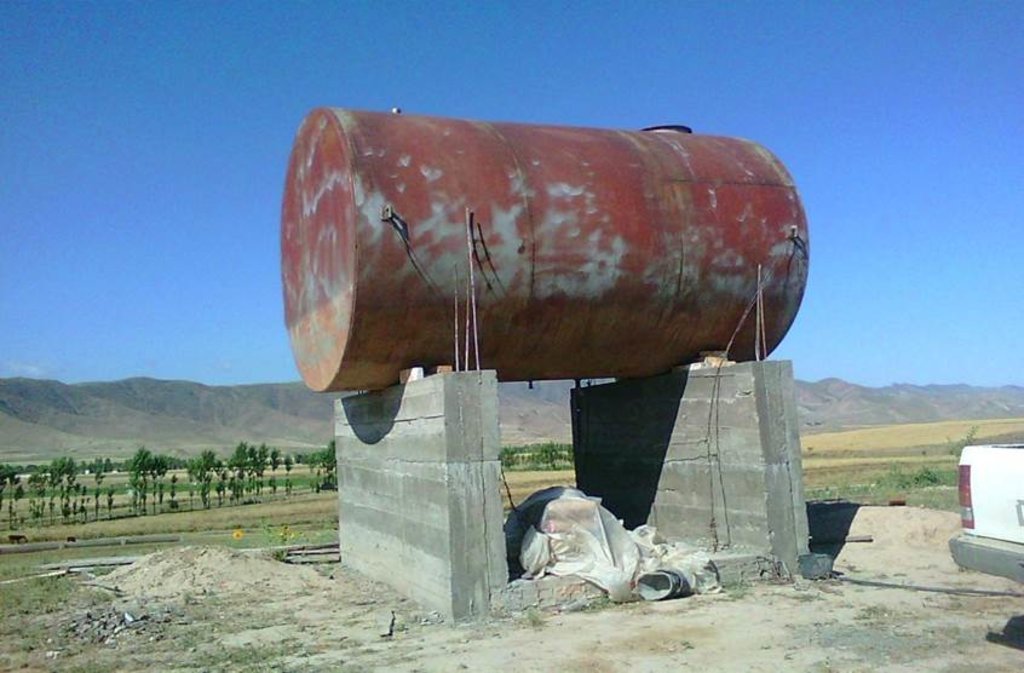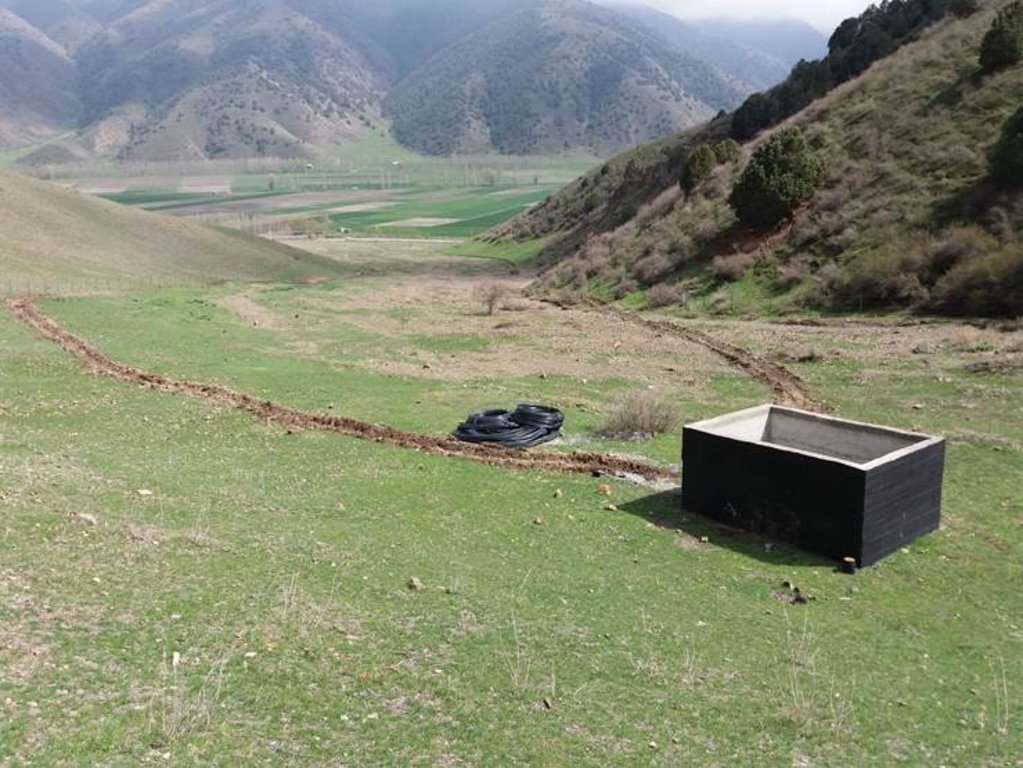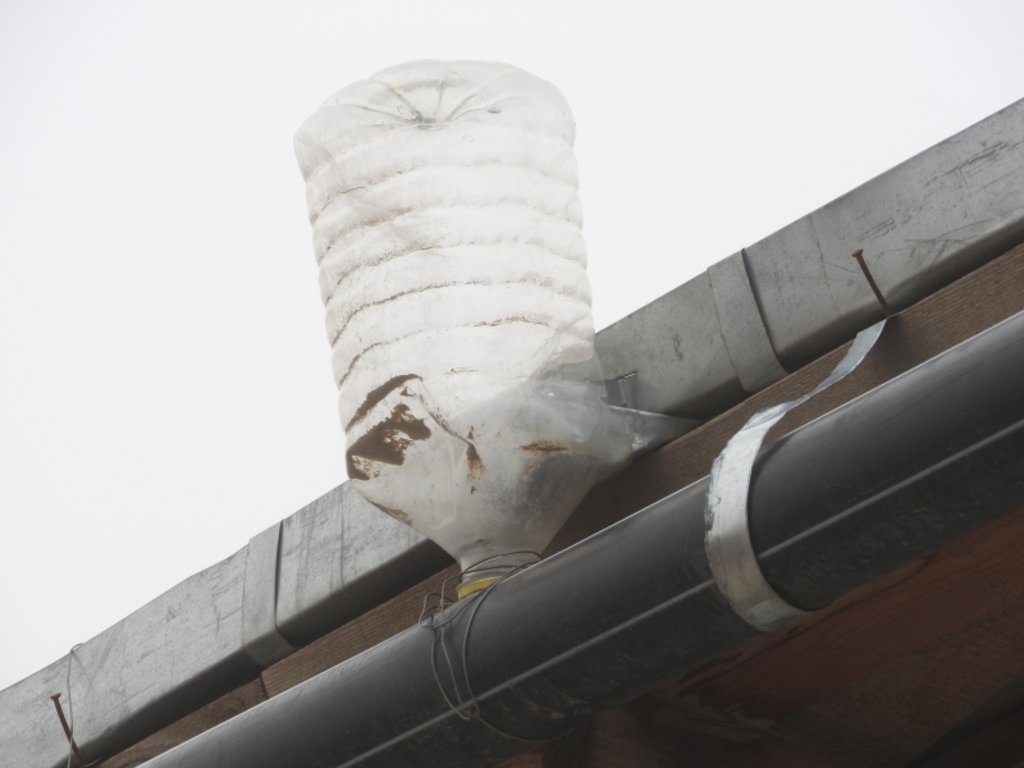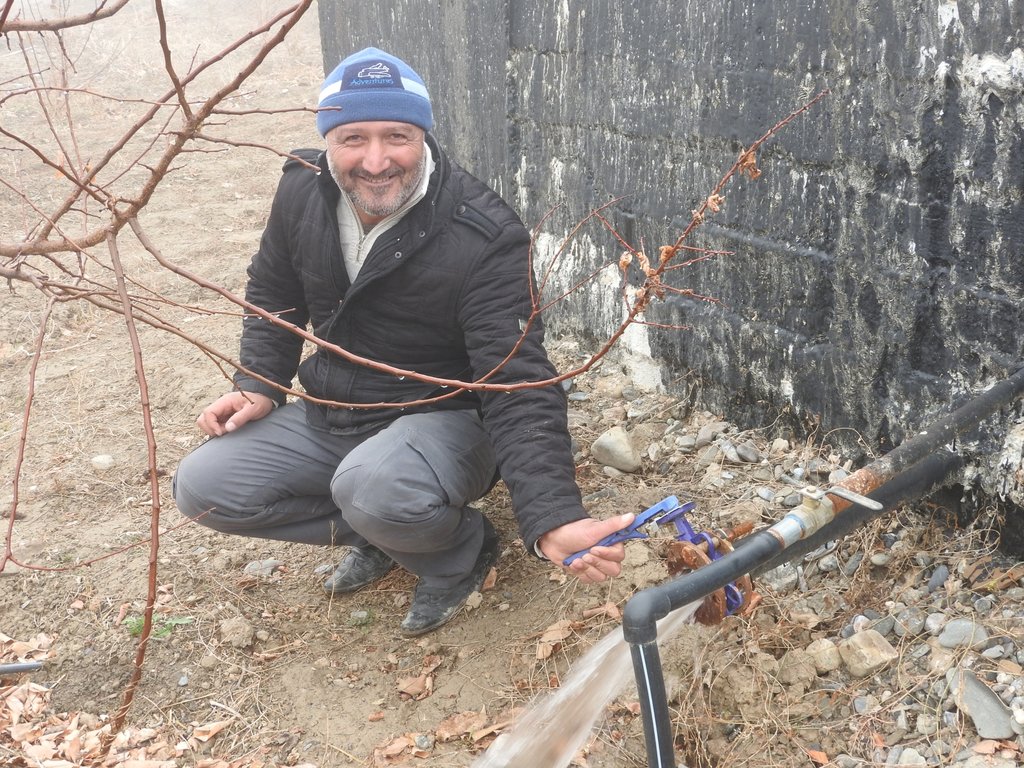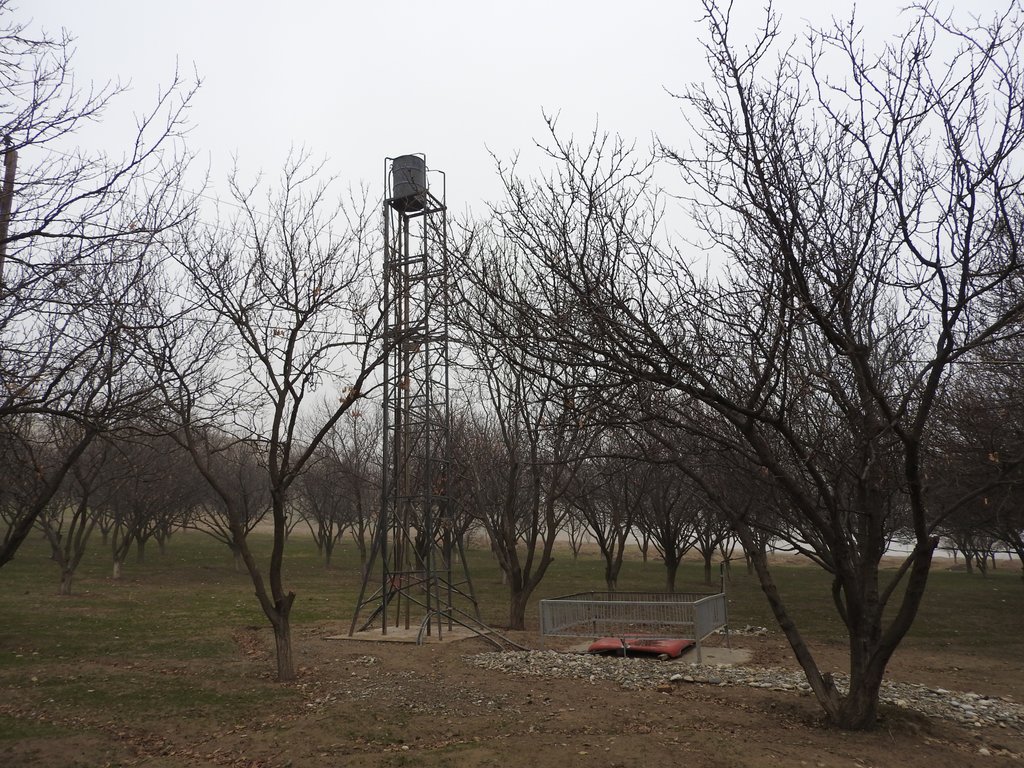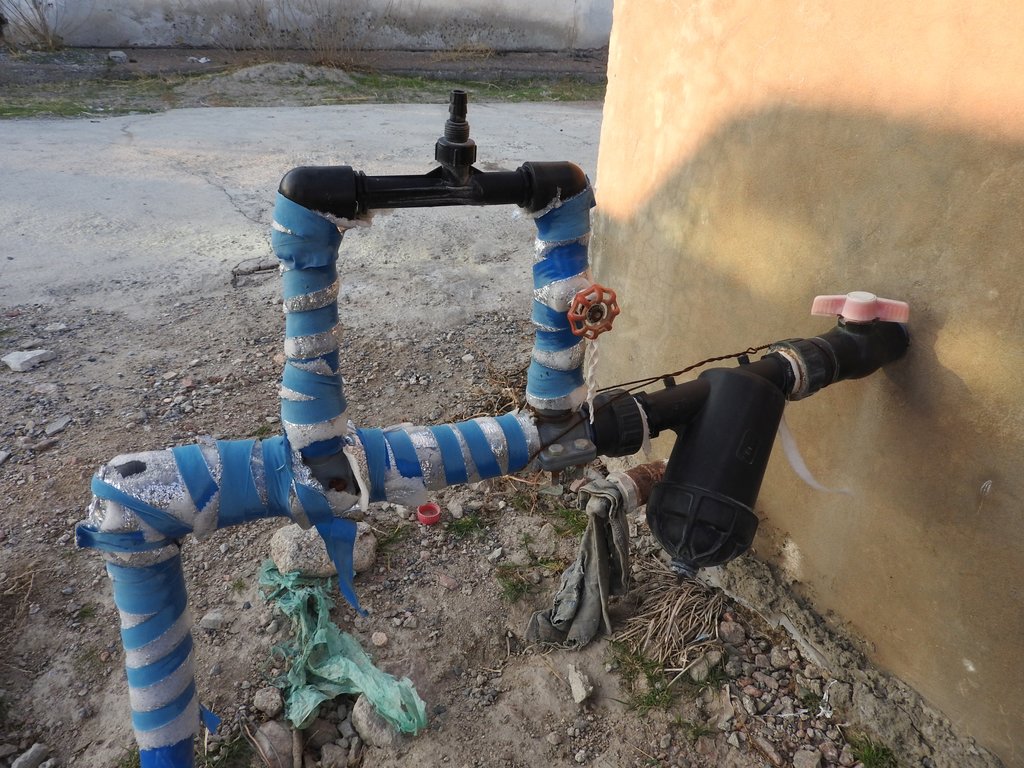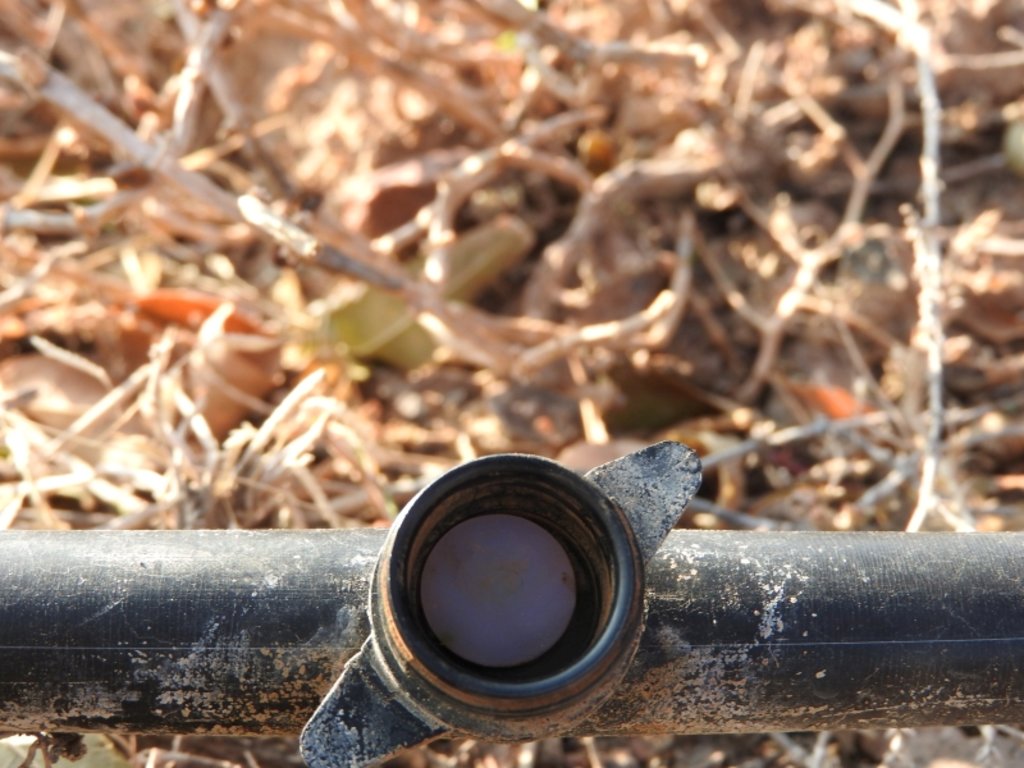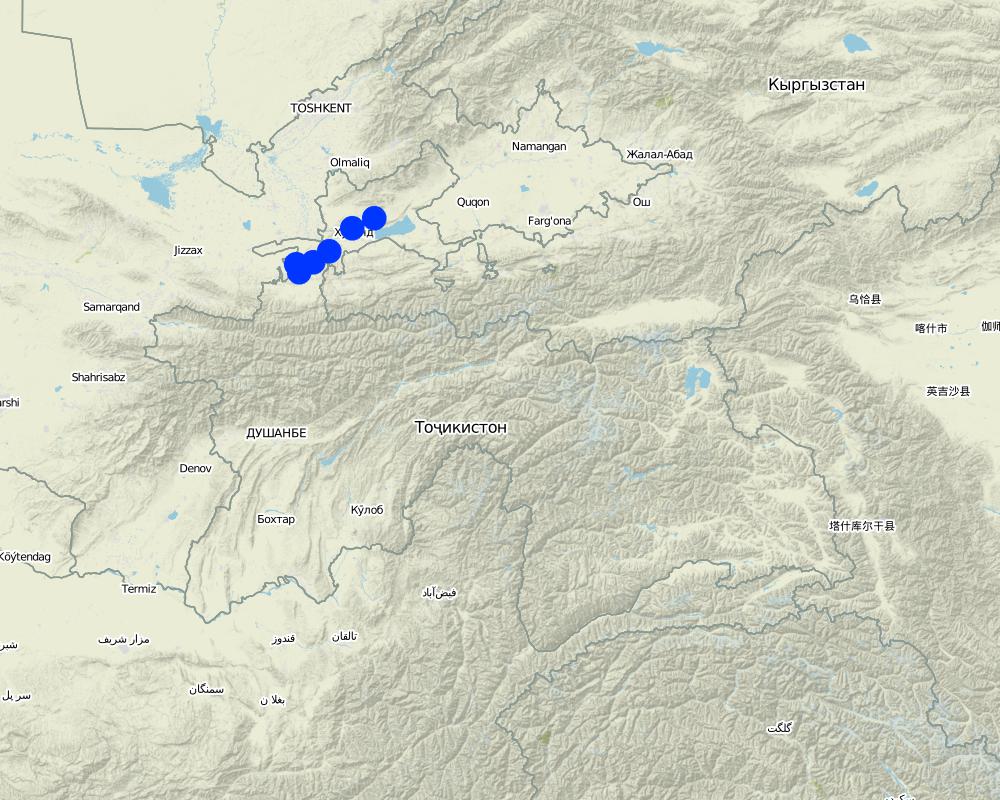Applying drip irrigation for efficient irrigation water use in varying contexts [ทาจิกิสถาน]
- ผู้สร้างสรรค์:
- การอัพเดท:
- ผู้รวบรวม: Stefan Michel
- ผู้เรียบเรียง: –
- ผู้ตรวจสอบ: Umed Vahobov
Применение технологии капельного орошения для эффективного использования ирригационной воды
technologies_4307 - ทาจิกิสถาน
ดูส่วนย่อย
ขยายทั้งหมด ย่อทั้งหมด1. ข้อมูลทั่วไป
1.2 รายละเอียดที่ติดต่อได้ของผู้รวบรวมและองค์กรที่เกี่ยวข้องในการประเมินและการจัดเตรียมทำเอกสารของเทคโนโลยี
วิทยากรหลัก
ผู้เชี่ยวชาญ SLM:
Muhidinov Nodir
Deutsche Gesellschaft für Internationale Zusammenarbeit (GIZ)
ทาจิกิสถาน
ผู้เชี่ยวชาญ SLM:
Negmatov Negmatjon
Deutsche Gesellschaft für Internationale Zusammenarbeit (GIZ)
ทาจิกิสถาน
ชื่อของโครงการซึ่งอำนวยความสะดวกในการทำเอกสารหรือการประเมินเทคโนโลยี (ถ้าเกี่ยวข้อง)
Strengthening of Livelihoods through Climate Change Adaptation in Kyrgyzstan and Tajikistanชื่อขององค์กรซึ่งอำนวยความสะดวกในการทำเอกสารหรือการประเมินเทคโนโลยี (ถ้าเกี่ยวข้อง)
Deutsche Gesellschaft für Internationale Zusammenarbeit - Tajikistan (GIZ Tajikistan) - ทาจิกิสถาน1.3 เงื่อนไขการใช้ข้อมูลที่ได้บันทึกผ่านทาง WOCAT
ผู้รวบรวมและวิทยากรหลักยอมรับเงื่อนไขเกี่ยวกับการใช้ข้อมูลที่ถูกบันทึกผ่านทาง WOCAT:
ใช่
1.4 การเปิดเผยเรื่องความยั่งยืนของเทคโนโลยีที่ได้อธิบายไว้
เทคโนโลยีที่ได้อธิบายไว้นี้เป็นปัญหาของความเสื่อมโทรมโทรมของที่ดินหรือไม่ จึงไม่ได้รับการยอมรับว่าเป็นเทคโนโลยีเพื่อการจัดการที่ดินอย่างยั่งยืน:
ไม่ใช่
1.5 Reference to Questionnaire(s) on SLM Approaches (documented using WOCAT)
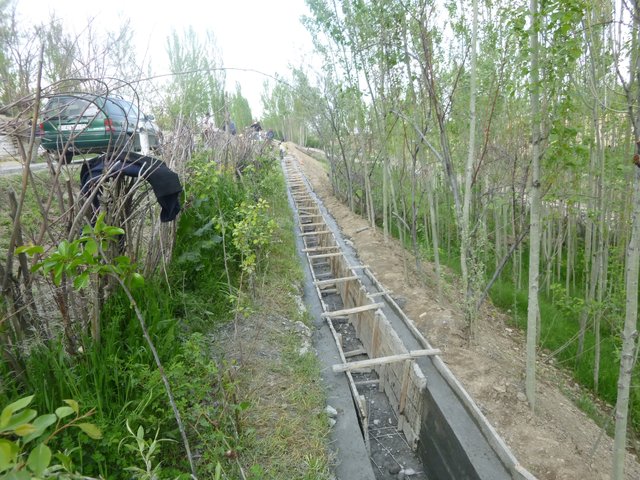
Increased efficiency of irrigation water use to address … [ทาจิกิสถาน]
Climate change impact contributes to irrigation water shortage. The approach of improving irrigation water delivery, distribution and use prevents irrigation water losses and increases the productivity per amount of irrigation water available.
- ผู้รวบรวม: Stefan Michel
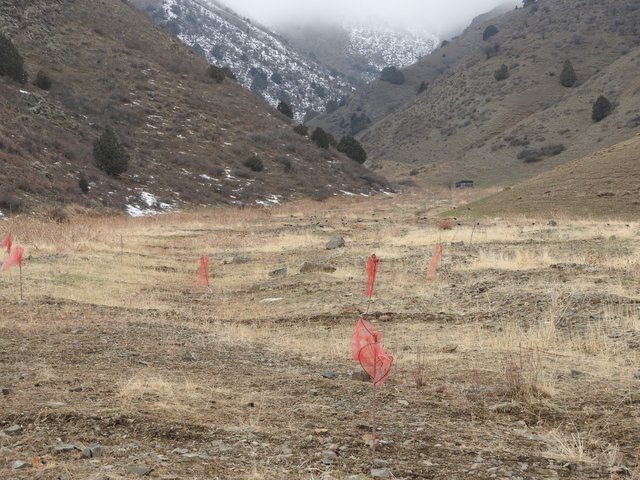
Disaster risk reduction and sustainable land-use by integrated … [ทาจิกิสถาน]
A site affected by a debris flow was rehabilitated by joint communal work and integrated preventive measures addressing the upper catchment as well as the valley and the debris conus were implemented in collaboration of community, individual farmers, Committee of Emergency Situations and forestry enterprise.
- ผู้รวบรวม: Stefan Michel
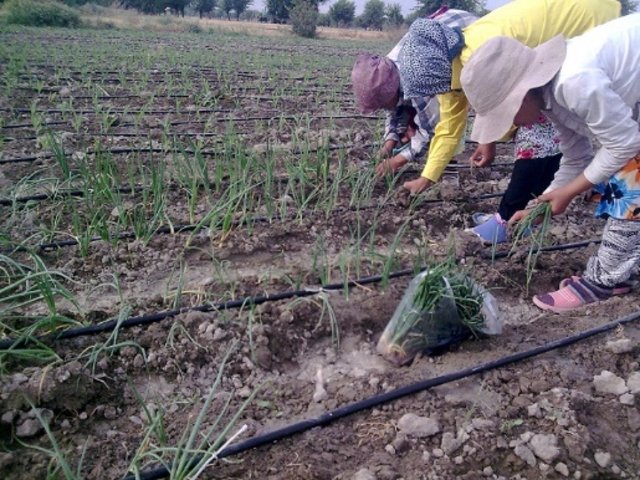
Integrated farming on irrigated lands for adaptation to … [ทาจิกิสถาน]
Irrigated agriculture faces challenges from climate change impact and growing competition for irrigation water. The approach to get "more crop per drop" reduces the adverse effect of these impacts and improves the income of farmers.
- ผู้รวบรวม: Stefan Michel
2. การอธิบายลักษณะของเทคโนโลยี SLM
2.1 การอธิบายแบบสั้น ๆ ของเทคโนโลยี
คำจำกัดความของเทคโนโลยี:
Drip irrigation substantially saves water compared to conventional furrow irrigation. Here the technology is applied for different perennial and annual crops and with use of different sources of water.
2.2 การอธิบายแบบละเอียดของเทคโนโลยี
คำอธิบาย:
In the arid areas of Sughd region cultivation of most crops is possible with irrigation only. In many cases conventional furrow irrigation is limited or impossible due to insufficient availability of irrigation water. Furthermore, conventional furrow irrigation is often connected with problems which make irrigated farming unsustainable – high water demand causes shortages for downstream water users and ecosystems, irrigation water can flush out nutrients from soil or cause erosion, high amounts of irrigation water and insufficient drainage can lead to waterlogging and where soil and/or irrigation water contain high amounts of salt to salinization. From an economic perspective, the high amounts of irrigation water required for conventional irrigation can be costly, especially where pumping from sources to fields at higher elevation is required. Climate change impacts like increasing aridity, changing seasonality of rainfall, reduced storage of precipitation as snow and glacier ice and resulting irrigation water shortages during critical seasons require adaptation in irrigated agriculture.
The broader application of drip irrigation is one way to address economic and environmental issues of irrigated farming, while specifically addressing climate change impact. The major effect of drip irrigation is the increased irrigation water use efficiency – “More crop per drop”. This avoids or reduces the above explained impacts of conventional furrow irrigation: water demand is massively reduced allowing irrigating fields and orchards in areas where water availability would not allow for conventional irrigated agriculture; loss of soil nutrients, irrigation induced erosion and waterlogging are avoided, salinization is much less likely and occurs only in small extent in cases where highly mineralized irrigation water is applied (not an issue in the described project region). The reduced need for irrigation water avoids conflict with downstream water users and the needs of ecosystems. Under climate change impact farmers applying drip irrigation have a higher security that sufficient irrigation water is available and the drip irrigation technology allows for an adapted provision of water to the crops in accordance to their physiological demand. Drip irrigation systems can be used to apply the accurate dosages of fertilizer directly to the plants. This increases the effectiveness of fertilizing and the efficiency in terms of costs as much less fertilizer is not taken by the crops.
Drip irrigation is applied for various crops:
•perennial crops: orchards of apple, apricot, pear and other fruit trees, vineyards, lemons in greenhouses;
•corn, onions, potatoes; and
•honey melon and water melon.
The high initial investment influences on the economic profitability of the technology. The project demonstrated that drip irrigation can be used not only for orchards, where it has an advantage over field crops, because there is no need re-install pipes every season. But it can be used for crops such as melons, onion, sunflower and corn. In the case of honey melon and water melon drip irrigation is particularly efficient due to the large area covered by every single plant. Thus the distances between pipes and between drippers can be large to supply each plant, but the plants with their long tendrils and large leaves effectively use the space in between. In trials of onion cultivation the generally high investment needs, required density of tubes and drippers and the comparably low market price made the technology in not economically competitive under current circumstances.
Drip irrigation can be applied with various sources of irrigation water. Compared to conventional furrow irrigation even low amounts of irrigation water or water from comparably costly sources can be effectively used. In the frame of the documented trials the following sources of irrigation water have been used for supplying drip irrigation systems in addition to water from irrigation canals:
•spring water collection with concrete reservoir;
•water from draw well, pumped to small water tower above the well and from their running by gravitation to concrete reservoir, from where it is supplying the drip irrigation system;
•rain water collection from house roofs with concrete reservoir;
•irrigation water withdrawn by large pumps from Syrdarya river and supplied via pipelines to newly irrigated areas;
•irrigation water from household water supply system, stored in concrete reservoir during day times of low demand.
The drip irrigation systems are equipped with manual (use of local irrigation water stored in concrete reservoirs or barrels) or automatic (direct use of irrigation water from pipelines) pressure regulation valves. At the outlets of reservoirs or at the pressure regulations device fertilizer can be added and provided to the plants in exact dosage.
2.3 รูปภาพของเทคโนโลยี
2.5 ประเทศภูมิภาค หรือสถานที่ตั้งที่เทคโนโลยีได้นำไปใช้และได้รับการครอบคลุมโดยการประเมินนี้
ประเทศ:
ทาจิกิสถาน
ภูมิภาค/รัฐ/จังหวัด:
Sughd region
ระบุการกระจายตัวของเทคโนโลยี:
- ใช้ ณ จุดที่เฉพาะเจาะจงหรือเน้นไปยังบริเวณพื้นที่ขนาดเล็ก
Is/are the technology site(s) located in a permanently protected area?
ไม่ใช่
Map
×2.6 วันที่การดำเนินการ
ระบุปีที่ใช้:
2017
ถ้าไม่รู้ปีที่แน่นอน ให้ระบุวันที่โดยประมาณ:
- น้อยกว่า 10 ปี (ไม่นานนี้)
2.7 คำแนะนำของเทคโนโลยี
ให้ระบุว่าเทคโนโลยีถูกแนะนำเข้ามาอย่างไร:
- ทางโครงการหรือจากภายนอก
3. การจัดประเภทของเทคโนโลยี SLM
3.1 วัตถุประสงค์หลักของเทคโนโลยี
- ปรับปรุงการผลิตให้ดีขึ้น
- ปรับตัวเข้ากับการเปลี่ยนแปลงภูมิอากาศของโลก สภาพภูมิอากาศที่รุนแรงและผลกระทบ
- สร้างผลกระทบทางด้านเศรษฐกิจที่เป็นประโยชน์
- สร้างผลกระทบทางด้านสังคมที่เป็นประโยชน์
3.2 ประเภทของการใช้ที่ดินในปัจจุบันที่ได้นำเทคโนโลยีไปใช้
Land use mixed within the same land unit:
ไม่ใช่

พื้นที่ปลูกพืช
- การปลูกพืชล้มลุกอายุปีเดียว
- การปลูกพืชยืนต้นที่ไม่มีเนื้อไม้
- การปลูกไม้ยืนต้น ไม้พุ่ม
Annual cropping - Specify crops:
- cereals - maize
- oilseed crops - sunflower, rapeseed, other
- vegetables - melon, pumpkin, squash or gourd
- vegetables - root vegetables (carrots, onions, beet, other)
Tree and shrub cropping - Specify crops:
- citrus
- fruits, other
- grapes
จำนวนของฤดูเพาะปลูกต่อปี:
- 1
Is intercropping practiced?
ไม่ใช่
Is crop rotation practiced?
ใช่
3.3 Has land use changed due to the implementation of the Technology?
Has land use changed due to the implementation of the Technology?
- Yes (Please fill out the questions below with regard to the land use before implementation of the Technology)
Land use mixed within the same land unit:
ไม่ใช่

ทุ่งหญ้าเลี้ยงสัตว์
- unregulated
Animal type:
- goats
- sheep

ที่ดินที่ไม่ให้ผลผลิต
ระบุ:
Desert/deserted rangeland
3.4 การใช้น้ำ
การใช้น้ำของที่ดินที่มีการใช้เทคโนโลยีอยู่:
- การชลประทานแบบเต็มรูปแบบ
3.5 กลุ่ม SLM ที่ตรงกับเทคโนโลยีนี้
- การเก็บเกี่ยวน้ำ
- การจัดการด้านชลประทาน (รวมถึงการลำเลียงส่งน้ำ การระบายน้ำ)
3.6 มาตรการ SLM ที่ประกอบกันเป็นเทคโนโลยี

มาตรการอนุรักษ์ด้วยโครงสร้าง
- S7: การกักเก็บน้ำ/การส่งลำเลียง/อุปกรณ์การชลประทาน
3.7 รูปแบบหลักของการเสื่อมโทรมของที่ดินที่ได้รับการแก้ไขโดยเทคโนโลยี

การกัดกร่อนของดินโดยน้ำ
- Wt (Loss of topsoil): การสูญเสียดินชั้นบนหรือการกัดกร่อนที่ผิวดิน
- Wg (Gully erosion): การกัดกร่อนแบบร่องธารหรือการทำให้เกิดร่องน้ำเซาะ

การเสื่อมโทรมของดินทางด้านเคมี
- Cn (Fertility decline): ความอุดมสมบูรณ์และปริมาณอินทรียวัตถุในดินถูกทำให้ลดลงไป (ไม่ได้เกิดจากสาเหตุการกัดกร่อน)
- Cs (Salinization/alkalinization): การสะสมเกลือหรือการทำให้เป็นด่าง
3.8 การป้องกัน การลดลง หรือการฟื้นฟูความเสื่อมโทรมของที่ดิน
ระบุเป้าหมายของเทคโนโลยีกับความเสื่อมโทรมของที่ดิน:
- ลดความเสื่อมโทรมของดิน
- ปรับตัวกับสภาพความเสื่อมโทรมของที่ดิน
4. ข้อมูลจำเพาะด้านเทคนิค กิจกรรมการนำไปปฏิบัติใช้ ปัจจัยนำเข้า และค่าใช้จ่าย
4.2 ข้อมูลทั่วไปเกี่ยวกับการคำนวณปัจจัยนำเข้าและค่าใช้จ่าย
ให้ระบุว่าค่าใช้จ่ายและปัจจัยนำเข้าได้รับการคำนวณอย่างไร:
- ต่อพื้นที่ที่ใช้เทคโนโลยี
ระบุขนาดและหน่วยพื้นที่:
ha
อื่นๆ หรือสกุลเงินประจำชาติ (ระบุ):
TJS
If relevant, indicate exchange rate from USD to local currency (e.g. 1 USD = 79.9 Brazilian Real): 1 USD =:
8.0
4.3 กิจกรรมเพื่อการจัดตั้ง
| กิจกรรม | Timing (season) | |
|---|---|---|
| 1. | Construction of water supply and storage structures | before irrigation season |
| 2. | Installation of drip irrigation system | early in spring |
| 3. | Draining of water storages and drip irrigation system | before cold season sets in |
4.4 ค่าใช้จ่ายของปัจจัยนำเข้าที่จำเป็นสำหรับการจัดตั้ง
| ปัจจัยนำเข้า | หน่วย | ปริมาณ | ค่าใช้จ่ายต่อหน่วย | ค่าใช้จ่ายทั้งหมดต่อปัจจัยนำเข้า | %ของค่าใช้จ่ายที่ก่อให้เกิดขึ้นโดยผู้ใช้ที่ดิน | |
|---|---|---|---|---|---|---|
| แรงงาน | Construction of water withdrawal systems | |||||
| แรงงาน | Construction of rainwater harvest systems | |||||
| แรงงาน | Construction of water storage | |||||
| แรงงาน | Installation of drip irrigation systems | ha | 5.0 | 2800.0 | 14000.0 | |
| วัสดุสำหรับก่อสร้าง | Water withdrawal systems | |||||
| วัสดุสำหรับก่อสร้าง | Rainwater harvest systems | |||||
| วัสดุสำหรับก่อสร้าง | Water storage systems | |||||
| วัสดุสำหรับก่อสร้าง | Drip irrigation system orchard | ha | 5.0 | 7000.0 | 35000.0 | |
| วัสดุสำหรับก่อสร้าง | Drip irrigation system onion field | ha | 1.0 | 20000.0 | 20000.0 | |
| ค่าใช้จ่ายทั้งหมดของการจัดตั้งเทคโนโลยี | 69000.0 | |||||
| Total costs for establishment of the Technology in USD | 8625.0 | |||||
ถ้าผู้ใช้ที่ดินรับภาระน้อยกว่า 100% ของค่าใช้จ่าย ให้ระบุว่าใครเป็นผู้รับผิดชอบส่วนที่เหลือ:
All investment costs of trials had been covered by the project
แสดงความคิดเห็น:
Costs vary between the specific situations, depending on type of crop, of water supply and of water storage as well as area sizes. Inquiries about detailed costs can be send to the project.
4.5 การบำรุงรักษาสภาพหรือกิจกรรมที่เกิดขึ้นเป็นประจำ
| กิจกรรม | ช่วงระยะเวลา/ความถี่ | |
|---|---|---|
| 1. | Refilling of water storage | Depending on specific situation |
| 2. | Regulation of water supply in drip irrigation system | Permanently during irrigation season |
| 3. | Control and cleaning of drippers as necessary | At least weekly |
4.6 ค่าใช้จ่ายของปัจจัยนำเข้าและกิจกรรมที่เกิดขึ้นเป็นประจำที่ต้องการการบำรุงรักษา (ต่อปี)
แสดงความคิดเห็น:
Costs vary between the specific situations, depending on type of crop, of water supply and of water storage as well as area sizes. Inquiries about detailed costs can be send to the project.
4.7 ปัจจัยสำคัญที่สุดที่มีผลกระทบต่อค่าใช้จ่าย
ปัจจัยสำคัญที่สุดที่มีผลกระทบต่อค่าใช้จ่ายต่างๆ:
Water supply and storage systems, densities of drip irrigation pipes and drippers.
5. สิ่งแวดล้อมทางธรรมชาติและของมนุษย์
5.1 ภูมิอากาศ
ฝนประจำปี
- < 250 ม.ม.
- 251-500 ม.ม.
- 501-750 ม.ม.
- 751-1,000 ม.ม.
- 1,001-1,500 ม.ม.
- 1,501-2,000 ม.ม.
- 2,001-3,000 ม.ม.
- 3,001-4,000 ม.ม.
- > 4,000 ม.ม.
ระบุปริมาณน้ำฝนเฉลี่ยรายปี (ถ้ารู้) :หน่วย ม.ม.
221.00
ข้อมูลจำเพาะ/ความคิดเห็นเรื่องปริมาณน้ำฝน:
Rainfall varies between sites
ระบุชื่อของสถานีตรวดวัดอากาศที่ใช้อ้างอิงคือ:
Khujand
เขตภูมิอากาศเกษตร
- กึ่งแห้งแล้ง
- แห้งแล้ง
5.2 สภาพภูมิประเทศ
ค่าเฉลี่ยความลาดชัน:
- ราบเรียบ (0-2%)
- ลาดที่ไม่ชัน (3-5%)
- ปานกลาง (6-10%)
- เป็นลูกคลื่น (11-15%)
- เป็นเนิน (16-30%)
- ชัน (31-60%)
- ชันมาก (>60%)
ธรณีสัณฐาน:
- ที่ราบสูง/ที่ราบ
- สันเขา
- ไหล่เขา
- ไหล่เนินเขา
- ตีนเนิน
- หุบเขา
ระดับความสูง:
- 0-100 เมตร
- 101-500 เมตร
- 501-1,000 เมตร
- 1,001-1,500 เมตร
- 1,501-2,000 เมตร
- 2,001-2,500 เมตร
- 2,501-3,000 เมตร
- 3,001-4,000 เมตร
- > 4,000 เมตร
ความคิดเห็นและข้อมูลจำเพาะเพิ่มเติมเรื่องสภาพภูมิประเทศ:
Various altitudes.
5.3 ดิน
(ถ้ามี) ให้แนบคำอธิบายเรื่องดินแบบเต็มหรือระบุข้อมูลที่มีอยู่ เช่น ชนิดของดิน ค่า pH ของดินหรือความเป็นกรดของดิน ความสามารถในการแลกเปลี่ยนประจุบวก ไนโตรเจน ความเค็ม เป็นต้น:
Various soil situations
5.4 ความเป็นประโยชน์และคุณภาพของน้ำ
น้ำไหลบ่าที่ผิวดิน:
ไม่ดีหรือไม่มีเลย
ความเค็มของน้ำเป็นปัญหาหรือไม่:
ไม่ใช่
กำลังเกิดน้ำท่วมในพื้นที่หรือไม่:
ไม่ใช่
ความคิดเห็นและข้อมูลจำเพาะเพิ่มเติมเรื่องคุณภาพและปริมาณน้ำ:
Grond water table varying between <5 m and >50 m.
5.5 ความหลากหลายทางชีวภาพ
ความหลากหลายทางชนิดพันธุ์:
- ต่ำ
ความหลากหลายของแหล่งที่อยู่:
- ต่ำ
5.6 ลักษณะของผู้ใช้ที่ดินที่นำเทคโนโลยีไปปฏิบัติใช้
อยู่กับที่หรือเร่ร่อน:
- อยู่กับที่
แนวทางการตลาดของระบบการผลิต:
- mixed (subsistence/ commercial)
รายได้ที่มาจากนอกฟาร์ม:
- < 10% ของรายได้ทั้งหมด
- 10-50% ของรายได้ทั้งหมด
ระดับของความมั่งคั่งโดยเปรียบเทียบ:
- พอมีพอกิน
เป็นรายบุคคล/ครัวเรือน:
- เป็นรายบุคคล/ครัวเรือน
- กลุ่ม/ชุมชน
ระดับของการใช้เครื่องจักรกล:
- งานที่ใช้แรงกาย
- การใช้เครื่องจักรหรือเครื่องยนต์
เพศ:
- หญิง
- ชาย
อายุของผู้ใช้ที่ดิน:
- เด็ก
- ผู้เยาว์
- วัยกลางคน
- ผู้สูงอายุ
5.7 Average area of land used by land users applying the Technology
- < 0.5 เฮกตาร์
- 0.5-1 เฮกตาร์
- 1-2 เฮกตาร์
- 2-5 เฮกตาร์
- 5-15 เฮกตาร์
- 15-50 เฮกตาร์
- 50-100 เฮกตาร์
- 100-500 เฮกตาร์
- 500-1,000 เฮกตาร์
- 1,000-10,000 เฮกตาร์
- >10,000 เฮกตาร์
พิจารณาว่าเป็นขนาดเล็ก กลาง หรือขนาดใหญ่ (ซึ่งอ้างอิงถึงบริบทระดับท้องถิ่น):
- ขนาดเล็ก
- ขนาดกลาง
5.8 กรรมสิทธิ์ในที่ดิน สิทธิในการใช้ที่ดินและสิทธิในการใช้น้ำ
กรรมสิทธิ์ในที่ดิน:
- รัฐ
สิทธิในการใช้ที่ดิน:
- รายบุคคล
- Kindergarten, gov't agency
สิทธิในการใช้น้ำ:
- เกี่ยวกับชุมชน (ถูกจัดระเบียบ)
- รายบุคคล
- Gov't organizations
Are land use rights based on a traditional legal system?
ไม่ใช่
5.9 การเข้าถึงบริการและโครงสร้างพื้นฐาน
สุขภาพ:
- จน
- ปานกลาง
- ดี
การศึกษา:
- จน
- ปานกลาง
- ดี
ความช่วยเหลือทางด้านเทคนิค:
- จน
- ปานกลาง
- ดี
การจ้างงาน (เช่น ภายนอกฟาร์ม):
- จน
- ปานกลาง
- ดี
ตลาด:
- จน
- ปานกลาง
- ดี
พลังงาน:
- จน
- ปานกลาง
- ดี
ถนนและการขนส่ง:
- จน
- ปานกลาง
- ดี
น้ำดื่มและการสุขาภิบาล:
- จน
- ปานกลาง
- ดี
บริการด้านการเงิน:
- จน
- ปานกลาง
- ดี
6. ผลกระทบและสรุปคำบอกกล่าว
6.1 ผลกระทบในพื้นที่ดำเนินการ (On-site) จากการใช้เทคโนโลยี
ผลกระทบทางด้านเศรษฐกิจและสังคม
การผลิต
การผลิตพืชผล
แสดงความคิดเห็น/ระบุ:
Varying, depending on crop and specific situation.
การเสี่ยงต่อความล้มเหลวในการผลิต
แสดงความคิดเห็น/ระบุ:
Varying, depending on crop and specific situation.
พื้นที่สำหรับการผลิต
แสดงความคิดเห็น/ระบุ:
Areas of several hundred hectares additionally cultivated (ongoing)
ความเป็นประโยชน์และคุณภาพของน้ำ
การมีน้ำไว้ให้สำหรับการชลประทาน
แสดงความคิดเห็น/ระบุ:
Absolute quantity of additionally available irrigation water is not high, but due to efficient use actually possible addtional irrigation is significant.
ความต้องการน้ำจากการชลประทาน
แสดงความคิดเห็น/ระบุ:
Actual consumption of irrigation water has not declined, but unsatisfied demand declined.
รายได้และค่าใช้จ่าย
ค่าใช่จ่ายของปัจจัยการผลิตทางการเกษตร
แสดงความคิดเห็น/ระบุ:
Expensive on-farm infrastructure required
ภาระงาน
แสดงความคิดเห็น/ระบุ:
Workload for installation and maintenance is higher than for conventional furrow irrigation.
ผลกระทบด้านนิเวศวิทยา
วัฐจักรน้ำหรือน้ำบ่า
ปริมาณน้ำ
แสดงความคิดเห็น/ระบุ:
Increase in area and productivity of irrigated lands without substantial increase of water withdrawal.
การเก็บเกี่ยวหรือการกักเก็บน้ำ
แสดงความคิดเห็น/ระบุ:
Use of water from previously not effectively used sources - rainwater from roofs, small springs, small wells.
ลดความเสี่ยงของภัยพิบัติ
ดินถล่ม/ ซากต่าง ๆ ที่ถูกพัดพามา
แสดงความคิดเห็น/ระบุ:
Use of drip irrigation for establishment of tree cover at debris flow site.
ผลกระทบจากภัยแล้ง
แสดงความคิดเห็น/ระบุ:
Improved drought resistance by better availability, regulation and efficient use of irrigation water
6.2 ผลกระทบนอกพื้นที่ดำเนินการ (Off-site) จากการใช้เทคโนโลยี
น้ำที่ใช้ประโยชน์ได้
แสดงความคิดเห็น/ระบุ:
Avoided reduction of water availability due to use of water efficient irrigation technology in newly irrigated areas.
ความเสียหายต่อพื้นที่เพาะปลูกของเพื่อนบ้าน
แสดงความคิดเห็น/ระบุ:
Use of drip irrigation for establishment of tree cover at debris flow site.
ความเสียหายต่อโครงสร้างพื้นฐานของรัฐหรือของเอกชน
แสดงความคิดเห็น/ระบุ:
Use of drip irrigation for establishment of tree cover at debris flow site.
6.3 การเผชิญและความตอบสนองของเทคโนโลยีต่อการเปลี่ยนแปลงสภาพภูมิอากาศที่ค่อยเป็นค่อยไป และสภาพรุนแรงของภูมิอากาศ / ภัยพิบัติ (ที่รับรู้ได้โดยผู้ใช้ที่ดิน)
การเปลี่ยนแปลงสภาพภูมิอากาศที่ค่อยเป็นค่อยไป
การเปลี่ยนแปลงสภาพภูมิอากาศที่ค่อยเป็นค่อยไป
| ฤดู | increase or decrease | เทคโนโลยีมีวิธีการรับมืออย่างไร | |
|---|---|---|---|
| อุณหภูมิตามฤดูกาล | ฤดูแล้ง | เพิ่มขึ้น | ดี |
| ฝนประจำปี | ลดลง | ดี | |
| ฝนตามฤดู | ลดลง | ดี |
6.4 การวิเคราะห์ค่าใช้จ่ายและผลประโยชน์ที่ได้รับ
ผลประโยชน์ที่ได้รับเปรียบเทียบกับค่าใช้จ่ายในการจัดตั้งเป็นอย่างไร (จากมุมมองของผู้ใช้ที่ดิน)
ผลตอบแทนระยะสั้น:
ด้านลบ
ผลตอบแทนระยะยาว:
ด้านบวก
ผลประโยชน์ที่ได้รับเปรียบเทียบกับค่าใช้จ่ายในการบำรุงรักษาหรือต้นทุนที่เกิดขึ้นซ้ำอีก เป็นอย่างไร (จากมุมมองของผู้ใช้ที่ดิน)
ผลตอบแทนระยะสั้น:
ด้านบวก
ผลตอบแทนระยะยาว:
ด้านบวก
แสดงความคิดเห็น:
High establishment costs.
6.5 การปรับตัวของเทคโนโลยี
- 1-10%
ถ้ามีข้อมูลให้บอกปริมาณด้วย (จำนวนของครัวเรือนหรือครอบคลุมพื้นที่):
Beyond the trials supported by the project the technology is now applied as standard irrigation technology in the newly irrigated areas of Sayhun.
Of all those who have adopted the Technology, how many did so spontaneously, i.e. without receiving any material incentives/ payments?
- 51-90%
แสดงความคิดเห็น:
Under consideration of the newly irrigated areas of Sayhun.
6.6 การปรับตัว
เทคโนโลยีได้รับการปรับเปลี่ยนเมื่อเร็วๆนี้ เพื่อให้ปรับตัวเข้ากับสภาพที่กำลังเปลี่ยนแปลงหรือไม่:
ไม่ใช่
6.7 จุดแข็ง / ข้อได้เปรียบ / โอกาสของเทคโนโลยี
| จุดแข็ง / ข้อได้เปรียบ / โอกาสในทัศนคติของผู้ใช้ที่ดิน |
|---|
| Irrigation possible in areas with irrigation water supply insufficient for conventional irrigation technologies. |
| Low amount of irrigation water needed for effective irrigation. |
| Potential of expansion of irrigated land use in previously non-irrigable areas. |
| จุดแข็ง / ข้อได้เปรียบ / โอกาสในทัศนคติของผู้รวบรวมหรือวิทยากรหลัก |
|---|
| Same as land-user's view. |
6.8 จุดอ่อน / ข้อเสียเปรียบ / ความเสี่ยงของเทคโนโลยีและวิธีการแก้ไข
| จุดอ่อน / ข้อเสียเปรียบ / ความเสี่ยงในทัศนคติของผู้ใช้ที่ดิน | มีวิธีการแก้ไขได้อย่างไร |
|---|---|
| Expensive initial investment |
External financial support; Choice of most efficient options, use of cheap versions. |
| Costs of replacement of damaged parts of the system and access to replacement parts |
External financial support; provision of replacement parts |
| จุดอ่อน / ข้อเสียเปรียบ / ความเสี่ยงในทัศนคติของผู้รวบรวมหรือวิทยากรหลัก | มีวิธีการแก้ไขได้อย่างไร |
|---|---|
| Expensive initial investment |
Decrease of costs as market of equipment becomes larger; Provision of access to suitable financing schemes; Application of the technology for crops with high cross margin per area unit/per investment in irrigation. |
| Costs of replacement of damaged parts of the system and access to replacement parts |
Capacity development on proper maintenance, in particular draining before the cold season; Assistance in purchase of durable parts via extension services/procurement cooperatives. |
7. การอ้างอิงและการเชื่อมต่อ
7.1 วิธีการและแหล่งข้อมูล
- ไปเยี่ยมชมภาคสนาม การสำรวจพื้นที่ภาคสนาม
- การสัมภาษณ์กับผู้ใช้ที่ดิน
- การสัมภาษณ์ผู้เชี่ยวชาญด้าน SLM หรือผู้ชำนาญ
วันที่เก็บรวบรวมข้อมูล(ภาคสนาม) :
27/11/2018
แสดงความคิดเห็น:
27-29/11/2018
ลิงก์และโมดูล
ขยายทั้งหมด ย่อทั้งหมดลิงก์

Increased efficiency of irrigation water use to address … [ทาจิกิสถาน]
Climate change impact contributes to irrigation water shortage. The approach of improving irrigation water delivery, distribution and use prevents irrigation water losses and increases the productivity per amount of irrigation water available.
- ผู้รวบรวม: Stefan Michel

Disaster risk reduction and sustainable land-use by integrated … [ทาจิกิสถาน]
A site affected by a debris flow was rehabilitated by joint communal work and integrated preventive measures addressing the upper catchment as well as the valley and the debris conus were implemented in collaboration of community, individual farmers, Committee of Emergency Situations and forestry enterprise.
- ผู้รวบรวม: Stefan Michel

Integrated farming on irrigated lands for adaptation to … [ทาจิกิสถาน]
Irrigated agriculture faces challenges from climate change impact and growing competition for irrigation water. The approach to get "more crop per drop" reduces the adverse effect of these impacts and improves the income of farmers.
- ผู้รวบรวม: Stefan Michel
โมดูล
ไม่มีโมดูล


